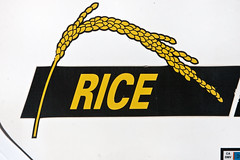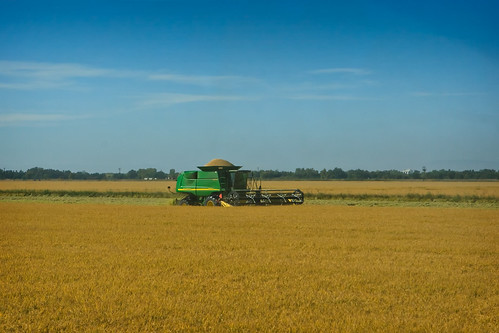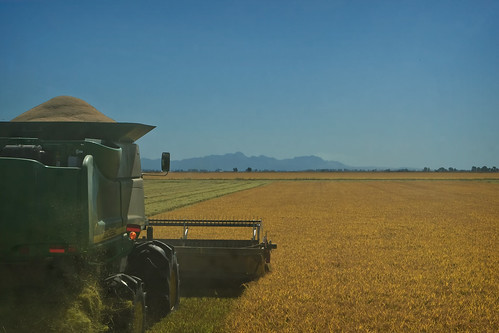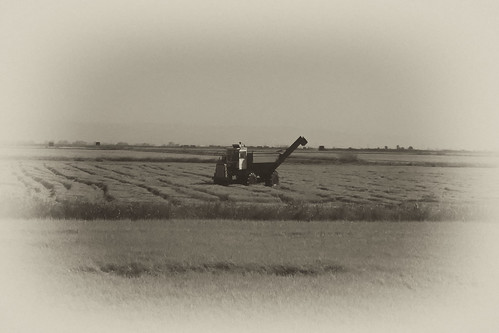When I was first dating Molly, she told me that her father was a rice farmer. Ignorantly, I replied, "Wow. That's really cool. Does he live with your family in California?" The answer was of course "Yes." Little did I know that the United States produces a good amount of rice annually, much of it exported to Asian countries.

In 1694, rice arrived in the United States in South Carolina from Madagascar. It is produced commercially in six states at an annual crop value of $2 billion and 12% of the world's rice trade. Rice cultivation began in California during the California Gold Rush, when an estimated 40,000 Chinese laborers immigrated to the state and grew small amounts of the grain for their own consumption. Commercial production began in 1912 in the town of Richvale in Butte County, where Molly's dad Carl still harvests rice. By 2006, California produced the second largest rice crop in the United States, a little over half the amount Arkansas produces.
As a grain, rice is harvested with combines in small segments of fields named checks, an area of about 40-50 acres surrounded by a levee for even flooding and growth. Once the rice has reached maturity in early fall, the fields are drained (it's a grass that grows in about 1 1/2 feet of water) and allowed to dry to decrease the moisture in the rice grain and make it easier for a heavy combine to drive on dry ground, not mud. I had the opportunity to ride with Carl yesterday in his buddy seat and learn about and observe the harvesting of rice.

Let me just tell you, this is not the rice harvest of 1960s Asia I had seen in "Good Morning Vietnam." Modern technology not only allows Carl to cut just the rice seeds off the top of the grain, but a small screen in his combine cab alerts him to rice yields, moisture content of the grain, and more - as he cuts! These things used to be figured out with math and weighing post-harvest. Now, Carl can speculate about his harvest yields--positive and negative--and the role that fertilizing, planting, watering, and weather played in his final crop.

On the harvester head, the rotating tines pull the grain into the sickle to be chopped. It travels to the center of the head on conveyor belts and is pulled under the cab. Here, the rice seeds are separated from the green grain. The rice is blown up into a receptacle, seen above as a mound on top of the John Deere combine, and the remaining green grass is blown out the rear of the combine like grass clippings. One of the most amazing aspects of rice harvest, though, is that Carl never leaves the combine cab. When his harvester is full, a bank-out truck pulls alongside the combine, a giant alien-like arm swings out over the bank-out loader, and the combine is emptied into the bank-out which then unloads it into a trailer to head to be shelled and dried in Richvale.

It was an amazing experience yesterday. I was in awe at the complexity of rice harvesting and that it has been going on in California rather successfully under the nose of many other ignorant people that have no idea California is a leading producer of rice! Learning about the science of rice agriculture and the mesmerizing movement of the combine were a great way to spend the middle of my day. Thanks again Carl. I'll leave you all with an antique-looking shot of the bank loader waiting for a full load in the field.

____________________
Eric
Eric Lovelin Photography

Thanks for the little rice lesson! Looks like you had fun.
ReplyDelete